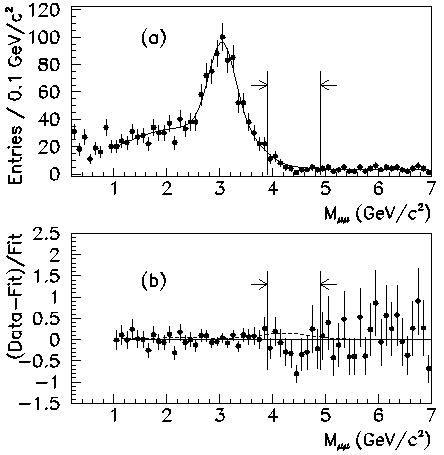Search for the Rare Decay b -> s mu+ mu-
February 11, 1998 The beauty of the Standard Model is in its ability to relate seemingly unrelated properties of its constituents. For example, what does the decay of the b quark have to do with the mass and decay properties of the top quark? Surely, the b quark with a mass of 5 GeV/c2 cannot decay into a top quark that is about 40 times heavier. It can only decay into a lighter quark. It can convert to a charmed (c) or an up (u) quark by emitting a virtual W- boson that later decays into a pair of quarks or leptons. A similar decay into a strange (s) or a down (d) quark is not allowed in the Standard Model: the Zo boson does not couple to two quarks of different flavors. The conversion of a b quark to an s quark is not absolutely forbidden though, it is just harder - it involves more intermediate steps. Consider the decay b -> s mu+ mu-, where the b quark turns into an s quark by emitting a pair of muons, as depicted in the diagram below. In this process, the muons don't come directly out of the b quark. First, the b quark converts to a virtual W- boson and a u, c, or t quark. Then, the intermediate quark emits a virtual Zo boson, which converts to a pair of muons. Finally, the quark recombines with the W into a final state s quark. All this occurs in such a short time that the Heisenberg's Uncertainty Principle allows the intermediate particles to be heavier than the particles present in the initial and final states. In fact, the strength of this process depends on the mass of the intermediate quark - and the higher it is, the better. Thus, the "loop" involving the top quark dominates over those with the virtual c and u quarks.

When the DØ ("D-Zero") Collaboration started collecting data, the top quark had not yet been discovered and, of course, its mass was unknown. So, it was impossible to predict precisely how frequent the decay b -> s mu+ mu- would be compared to the dominant decays with the c quark in the final state. Now, with the top quark mass known to be close to 170 GeV/c2, the Standard Model prediction for this decay is about six in a million. We have searched for events with a muon pair that might come from such a decay. We collected all events that had a muon pair with an invariant mass less than 7 GeV/c2. There are several known sources of such events, notably the charmonium decay, that peaks at 3.1 GeV/c2, the decay sequence b -> c mu-, c -> s mu+, for which the dimuon invariant mass peaks near 2 GeV/c2, and the case where a quark from the proton and an antiquark from the antiproton form a virtual photon that materializes as a muon pair. We looked for a deviation in the mass distribution from what was expected, that would indicate the presence of the decay b -> s mu+ mu- in our sample. No deviation was seen. The sum of all the known processes proved sufficient to explain the observed dimuon mass spectrum.

Of course, a lack of evidence for a process is not equivalent to proving that it does not exist. A negative result of a search leads to an estimate of an upper limit for its frequency. In this case, we were able to say that if the decay occurs in nature, it happens in less than one in 3000 events of the b quark decay. Thus, we confirmed that the "neutral current" transitions b -> s are strongly suppressed compared to the "charged current" transitions b -> c, in agreement with the Standard Model. Future experiments will tighten the limit, and eventually will measure the small rate of this decay. That will be an important test of the Standard Model. It may prove able to defend itself again. The rate for the b -> s transition will have to be consistent with the rate for the relatively rare decay of the top quark to an s quark, and to be in agreement with the Standard Model prediction for the measured top quark mass. On the other hand, any excess will be interpreted as indirect evidence for new particles, other than the quarks and the W and Z bosons, needed to describe the world as we know it today. A copy of the paper, in preprint form, is available from either Fermilab-Pub-98/033-E or hep-ex-9801027 . For further information contact Dr. Daria Zieminska, Indiana University, email: daria@ind.physics.indiana.edu |
| last modified 8/6/2001 |
| Security, Privacy, Legal | |